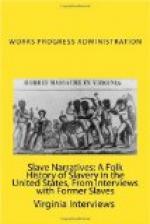Although only a child of five, Mr. Smith remembers the Civil War, especially the marching of thousands of soldiers, and the horse-drawn artillery wagons. The Stubblefields freed their slaves the first winter after the war.
On the Peter Stubblefield plantation the slaves were treated very well and had plenty to eat, while on the Robert Stubblefield plantation Mr Smith went hungry many times, and said, “Often, I would see a dog with a bit of bread, and I would have been willing to take it from him if I had not been afraid the dog would bite me.”
Mrs. Smith was named after Elizabeth Stubblefield, a relative of Peter Stubblefield. As a child of five years or less, Elizabeth had to spin “long reels five cuts a day,” pick seed from cotton, and cockle burrs from wool, and perform the duties of a house girl.
Unlike the chores of Elizabeth, Mr. Smith had to chop wood, carry water, chop weeds, care for cows, pick bugs from tobacco plants. This little boy had to go barefoot both summer and winter, and remembers the cracking of ice under his bare feet.
The day the mistress and master came and told the slaves they were free to go any place they desired, Mrs. Smith’s mother told her later that she was glad to be free but she had no place to go or any money to go with. Many of the slaves would not leave and she never witnessed such crying as went on. Later Mrs. Smith was paid for working. She worked in the fields for “wittels” and clothes. A few years later she nursed children for twenty-five cents a week and “wittels,” but after a time she received fifty cents a week, board and two dresses. She married Mr. Smith at the age of twenty.
Mr Smith’s father rented a farm and Mr. Smith has been a farmer all his life. The Smith couple have been married sixty-four years. Mrs. Smith says, “and never a cross word exchanged. Mr. Smith and I had no children.”
The room the writer was invited into was a combination bed-room and living room with a large heating stove in the centre of the small room. A bed on one side, a few chairs about the room. The floor was covered with an old patched rug. The only other room beside this room was a very small kitchen. The whole home was shabby and poor.
The only means of support the family has is a government old age pension which amounts to about fourteen dollars a month.
Their little shack is situated in the center of a large lot around which a very nice vegetable garden is planted. The property belongs to Mr. Harry Brazy, and the old couple does not pay rent or taxes and they may stay there as long as they live, “which is good enough for us,” says Mrs. Smith.
As the writer was leaving Mrs. Smith said, “I like to talk and meet people. Come again.”
Robert C. Irvin
Noblesville, Ind.
District #2
Ex-slave, life story of
Barney stone, former slave, Hamilton
Co.




